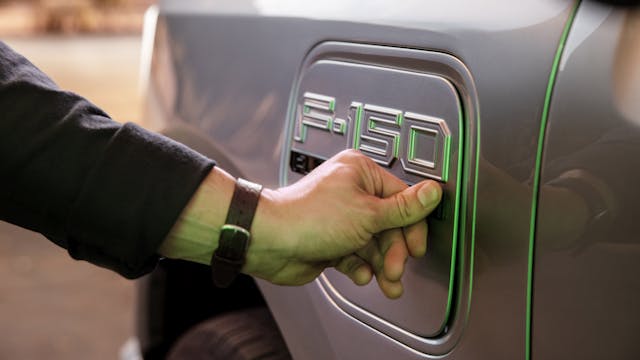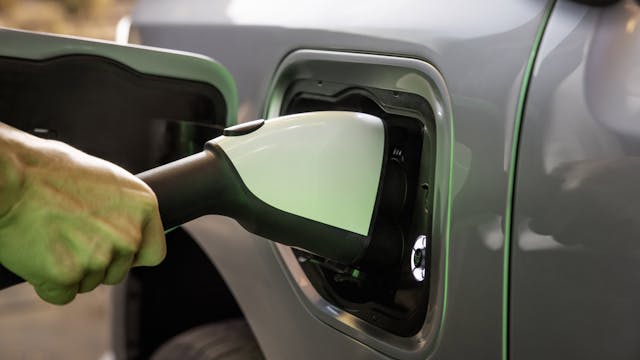Media | Articles
Revealed: 2022 Ford F-150 Lightning
Ford just yanked the silk off its new, all-electric 2022 F-150 Lightning pickup, the next salvo in the company’s wave of all-electric vehicles, following the E-Transit van line and controversial Mustang Mach-E. Although that pudgy pony and the rolling cargo-toaster were nice first steps, let’s make one thing clear: This all-electric pickup is arguably the company’s single most important EV release to date. Where American roads are concerned, it may even be the most important EV release in the whole car business.
Pickups are king in America, and nobody knows that better than Ford. The Motor Company’s F-150 pickup has sat contentedly atop this country’s truck-sales battle for 44 years. To keep that momentum rolling as the world’s highways go electric, the Blue Oval needs to prove that it’s done more than simply replace a fuel filler with a charge port. And the company cannot risk dulling the shine on a product line that both defines the company and is responsible for some $42 billion in annual revenue.

Numbers, and numbers in flux
We’ll roll out the heavy hitting figures first, but keep in mind that these are all targeted figures. An EV’s performance and range are easily tweaked through simple software changes, and validation testing within Ford—or the specs of a competitor like GMC’s Hummer EV—may end up persuading Dearborn to nudge the Lightning’s figures one way or another.
First, of course, are the golden numerals in the EV game: range. At launch, the F-150 Lightning will be offered with two battery sizes. Standard models are currently targeted for an EPA-estimated range of 230 miles. Ford says that extended-range Lightnings, available at greater cost, will shoot for 300.
As promised, the Lightning will also offer plenty of grunt. Standard-range trucks are currently planned for 426 hp, while the big-boy extended-range trucks should serve around 563 ponies. Ford aims to have both models offer 775 lb-ft of torque, all of which should, in traditional EV fashion, be available from a stop and closed throttle.
Marketplace
Buy and sell classics with confidence

The power figures for the extended-range Lightning are the highest offered on any production F-Series truck in history. All that torque should help propel the Lightning to 60 mph in under five seconds. (President Biden was allowed to drive the truck during a speaking event this week at Ford’s new Rouge Electric Vehicle complex. Of its acceleration, he said, “This sucker’s quick.”)
As far as “truck stuff” figures go, the Lightning appears capable of holding its own. Standard-range models are currently set for 7700 pounds of towing, with extended-range trucks capable of hauling up to 10,000 pounds. Because the extended-range battery pack is larger and heavier than the standard unit, payload suffers slightly: 1800 pounds to the standard model’s 2000. Predictably, Ford says that range during towing and hauling range was the number-one concern for potential customers surveyed. To assuage those worries, engineers cooked up a slick real-time range calculator that can take into account factors like weather, traffic, towing, and current payload in order to give an accurate sense of where you stand at a given moment in transit.

Filling up and drawing down
If range anxiety is the biggest hurdle for mass EV adoption, consider charging challenges a close second. Ford knows this, which is why so much of the initial information released for the Lightning seems aimed at addressing current infrastructure shortcomings.

With regard to charging while out-and-about, Ford says that if you plug your standard-range Lightning into a 150-kW DC fast-charger, a charge-up from 15 percent of battery capacity to 80 percent should take just 44 minutes. For the extended-range battery, the same charge time and delta is targeted at just 41 minutes, likely due to a more aggressive charge map.
Put another way: Hooked up to that 150-kW Level 3 fast-charger, an extended-range Lightning should offer around 54 miles of range after just 10 minutes of charging; the standard-range model should gain about 41 miles of range in the same time.

Talk to most EV owners, and they’ll tell you that the vast majority of charging happens at home. Each F-150 Lightning comes with a 240-volt home charger and 32-amp connector; the combination is capable of charging a standard-range Lightning from 15 percent to full in 14 hours, or an extended-range model in 19. Choose the optional 48-amp charge station, those times drop to 10 hours and 13 hours, respectively.
Prefer the miles-per-hour metric? Here’s a translation: With a standard-range Lightning, that 32-amp cord can dole out roughly 14 miles for every hour of charge. With the extended-range truck, it’s 13 miles every hour. The 48-amp unit bumps you to 19 and 20 miles, respectively.
To ease route planning on larger journeys or while towing, Ford has built software that can lay out the most efficient route between charge times and charging stations, similar to how a Tesla can plan routes using SuperCharger stations. The software knows if you’re towing or hauling and can make waypoint decisions in real time, ensuring that the charger it knows you can reach unladen is actually within reach if you’re towing a Mastercraft with a full bed.

Batteries bigger than ever
The F-150 Lightning’s battery employs lithium-ion pouch cells with nickel, manganese, and cobalt cathodes. As a whole, the pack represents the largest battery that Ford has ever put into production. The liquid-cooling system is controlled by battery-health software written in-house. Disappointingly, Dearborn has not yet released specific kWh figures for this pack, so we don’t know much about its size. That said, a quick extrapolation from charge rates would suggest that the standard-range Lightning battery sits around 140 kWh, and the extended-range pack around 180 kWh.

Power generation station
From the outset, these vehicles have been pitched as rolling power bricks. Like its hybridized siblings, the F-150 Lightning will offer Ford’s Pro Power Onboard feature, which allows the truck to power, by direct plug-in, everything from table saws to televisions. This system is available in either a base-rate 2.4-kW version or an upgraded 9.6-kW setup. The former offers eight 120-volt, three-prong outlets, while the latter provides 11 outlets, including an additional 240-volt receptacle in the bed.
New to the F-150 is a feature Ford calls Intelligent Backup Power. In the event of a power outage while your truck is plugged in at home, to Ford’s special 80-amp charge station, IBP will instruct your Lightning to serve as a backup generator for your home, offering up to 9.6 kW of juice. Ford claims that a fully charged Lightning should be capable of powering an ordinary home for around three days. When power is restored to the house, the truck’s charger will automatically revert to juicing the truck from the grid.

Independent rear SuperCrew
The F-150 Lightning looks similar to its gas-only and hybrid siblings. In fact, the SuperCrew cab—the only cab currently offered—is the same body assembly used on those models. For the most part, similarities end there. The electric truck wears an all-new, high-strength frame built to support that hefty battery and the sizable electric motor at each axle. The biggest change comes in the rear, where the F-150 Lightning sports independent suspension in place of the traditional live axle. All F-150 Lightnings will feature full-time four-wheel drive. During the truck’s unveiling, Lightning chief engineer Linda Zhang was proud to point out that the model underwent—and passed—the same rigorous durability and performance testing as its gasoline counterparts.

Computer-centric quarters
It should come as no surprise that this EV’s cabin appears aimed at a tech-focused buyer. Mid-trim Lariat and upper-trim Platinum models get a gargantuan 15.5-inch center touch screen in place of the 12-inch unit found in low-trim XLT Lightnings. A 12-inch digital instrument cluster is also standard across all trims. It’s there you will find helpful touches like the aforementioned real-time range calculator and a war room’s worth of information on battery health and power usage. (Seriously, it’s a lot of info. If you manage to run a battery dry in one of these rigs, that’s probably on you.)
Thankfully, the physical innovations that make the current F-150 so impressive also find their way aboard this EV pickup. The interior work surface still lets you lay the shifter flat and fold the center armrest out into a large, desk-like platform. Ford’s nifty tailgate work surface—it offers subtle touches like clamp pockets, pencil holders, and a phone stand—comes standard on Lariat and Platinum but remains optional on the XLT. Platinum trucks also receive Ford’s max-reclining seats, which fold nearly flat, for napping on the go.

How, how much, and when
The cheapest ticket to the Lightning storm will run you $39,974 before state and federal tax credits. That money gets you what Ford is calling a “commercially-oriented” variant. Despite that description, a Ford spokesperson did confirm that this base-of-base model will be made available to retail buyers as well as fleet customers. To get into a mid-tier XLT like the more modest of the trims mentioned above, you’ll be looking at a starting MSRP of $52,974 before tax credits. Fully-loaded Platinum trucks will clear the $90,000 mark.
As of this writing, Ford is accepting Lightning reservations at $100 per slot. Production is slated to begin in spring of 2022 at Ford’s Rouge Electric Vehicle Center.





















